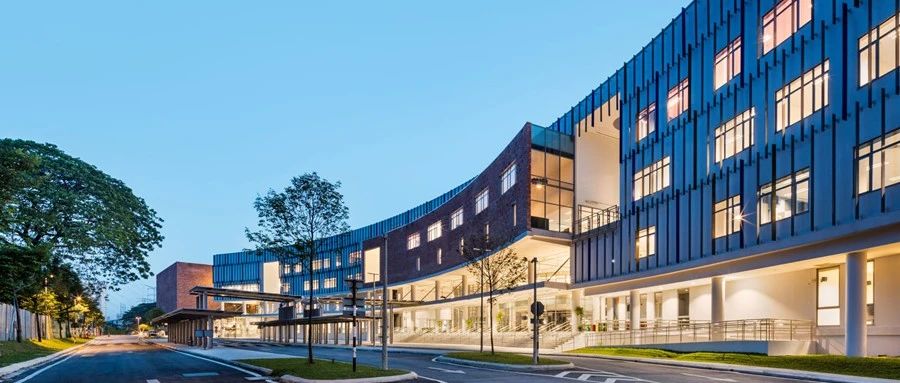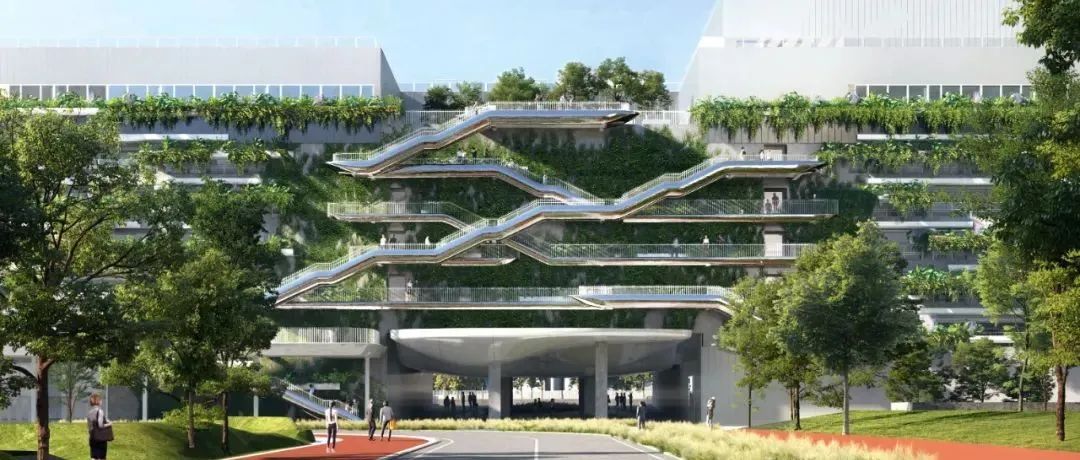绿色建筑白金级
地点:马来西亚 吉隆坡
面积:26 英亩/10.5 公顷
奖项:Cityscape智造奖—可持续发展项目奖
服务:建筑设计、可持续设计
吉隆坡国际学校在吉隆坡已经有50多年的历史,并已发展成为马来西亚最顶尖的学校之一。学校领导人们意识到为了使学校能够持续发展,他们需要一个新的校区。
新的校区是位于马来西亚首都市中心的一个占地10.5 公顷的城市绿洲。它是热带气候下可持续设计的典范,体现了学校向下一代领导者传授环境保护的使命。
一应俱全
HOK面临的挑战是如何将吉隆坡国际学校的幼儿、小学、初中和高中集中在同一个校区,同时保留每个学校的个性。团队与董事会合作,设计了 "校中校",同时可以保持共同的社区意识。校园可以满足3岁到18岁不同年龄段学生的不同需求,随着他们的升班,功能定位和布局也相应而变。
一条南北走向的弧形脊梁式连廊将教学区连接起来,并在学校的私用安全区域和城市的公共空间之间形成一道屏障。
每位来到校区的访客都会感到惊叹。从广袤视角到个中细节,它给人一种宏伟的感觉。校园里总是有热闹的气氛。......设计让每个人都能找到适合自己的空间。
Rami Madani
吉隆坡国际学校校长
学习曲线
将教学楼由东向西排列,可以更好地利用自然光,同时在每天日出与日落时保护教室免受强烈的阳光照射。每个教学区内的教学组群都可通向中央公共区域。
礼堂、演奏厅、画廊和剧院都围绕着一个中央露天剧场。这里是学校的心脏——所有年龄段的学生聚集在一起的地方。
学校还有世界一流的体育设施,包括了一个水上运动中心、网球场、室内体育馆、规范的跑道和田径场。
滑动查看更多图片 Scroll for more >>
良好的邻里关系
设计团队认为设计需要反映当地的文化。因为马来西亚的文化非常多元化,并且受到不同建筑风格的影响,这给设计工作增加了一定的复杂性。
为了让师生们缓解炎热,设计借鉴了马来西亚传统建筑的两个方面:屏风和遮挡。现有的成片景观植物和带屏风的外墙遮挡保护了学校的东侧。有遮盖的自然通风的走廊通向每个教学翼的中心。
学校致力于与社区共享资源和设施。学校与当地辖区一起举办教师培训课程,并欢迎文化协会组织的艺术表演和企业的慈善活动。校外体育俱乐部经常使用学校的体育设施。
成长的种子
通过种植自适应花卉和本土花卉推动了自然生态系统和生物多样性。
学校的课程将户外学习区结合进来。由学校园艺俱乐部维护的食材花园吸引当地的鸟类和昆虫。生态区设有回收中心和一个雨水调蓄池。散热凉爽的绿墙位于小学入口处。
学校利用雨水收集和回收再利用的灰水来灌溉学校的景观植物和进行一般清洗。
空气
被动式太阳能策略推动形成了建筑的现有形态和布局,建筑能耗比类似湿热气候下的学校减少60%。团队使用计算流体动力学(CFD)来分析遮阳、风能和太阳能增益。
教室南北两端的反光板将日光照入室内,最大限度地减少了对人工照明的需求。
过渡空间受益于从教室里逸出的冷空气。这些空间缓和了从炎热的室外移动到凉爽的室内环境受到的影响。
光线
外部屏风可以调节光线,同时提供隐私和遮阳。它们有助于塑造整体美感。
初中和高中下方的圆顶地下室提供了有遮挡的餐饮和社交空间。自然通风有遮挡的走廊通向每个教学翼的中心。错落有致排列在脊梁式连廊两侧的庭院,使微风能够穿过建筑。
构建教学工具
堆肥箱位于一个经常举办小学课程的生态花园中。屋顶花园让高年级学生在食品技术课上实现"从农场到餐桌 "的过程。
作为建筑管理系统(BMS)一部分的可视水电表能够显示学校的实时资源消耗,并鼓励学生节约能源。
利用非高峰期的电价,冷凝水在夜间冷却楼板。供水管道的轮廓被绘制出来,激发了学生和参观者的讨论。
长远目光
随着学校教学方法的演变发展,学习空间也可以随之变化。教室群落的设计是为了以最少的内部结构元素实现高度适应性。干墙隔断、平坦的楼板和大空间使得未来的重新配置变得容易。
学校希望日后在校园里能增加可再生能源。团队设计的屋顶可以安装太阳能电池板,提供大约总耗电量的5-10%。
所有建筑材料均从马来西亚当地采购,并特别注意到了韧性。还使用了含有可回收成分的材料,包括含有粉煤灰成分的绿色水泥和可回收成分的钢筋,以减少原材料采集和生产过程中的二氧化碳排放。
“做你自己”
吉隆坡国际学校的使命是挑战每个学生 "做自己",并培养他们成为非常成功且具有社会责任感的全球公民所需的习惯。
新的学习环境通过邀请学生真正参与和互动来支持学校的丰富课程。一名可持续发展顾问与学生、教职员工合作进行课程开发和社区项目。
吉隆坡国际学校是马来西亚首个获得马来西亚生态学校项目绿旗奖的学校。
International School of Kuala Lumpur
Green Building Index Platinum
Location: Kuala Lumpur, Malaysia
Size: 26 Acres / 10.5 Hectares
Awards: Cityscape Intelligence Awards – Sustainability Project Award
Services: Architecture, Sustainable Design
The International School of Kuala Lumpur (ISKL) has been established in Kuala Lumpur for over 50 years and has grown to become one of Malaysia’s leading schools. To position the school for continued growth, its leaders realized they needed a new campus.
The new ISKL is a 26-acre urban oasis in the heart of Malaysia’s capital city. It serves as a model for sustainable design in a tropical climate and embodies ISKL’s mission to teach environmental stewardship to the next generation of leaders.
All for One
HOK’s challenge was how to bring ISKL’s early years, elementary, middle and high schools together on one site while preserving each school’s individuality. The team worked with the Board to design “schools within a school” while maintaining a shared sense of community. The campus accommodates the different needs of each age group—students range from 3 to 18 years old—with programming and layouts changing as they progress.
A curved connecting spine aligned north-south links the teaching blocks and forms a threshold between the school’s secure private world and the city’s public realm.
Any visitor coming to the ISKL Ampang Hilir campus is in awe. From the vastness to the perspectives, it gives a feeling of grandeur. The campus is constantly buzzing. … The design allows everyone to find their own space.
Rami Madani, Head of School
The International School of Kuala Lumpur
Learning Curve
Aligning the teaching blocks to face east to west allows for high levels of daylight while protecting classrooms from intense sun at the beginning and end of each day. Teaching clusters within each block open to a central commons.
The auditorium, recital hall, gallery and theater are grouped around a central open amphitheater. This is the heart of the school—a place where ISKL students of all ages come together.
World-class athletic facilities include an aquatics center, tennis courts, indoor gymnasium, regulation track and fields.
Good Neighbor
The team understood that the design needed to reflect the local culture. This was complicated by the fact that Malaysia is so culturally diverse, with a variety of architectural influences.
To give students and faculty relief from the heat, the design borrows from two aspects of traditional Malaysian architecture: screens and shelter. Existing mature plantings and a screened facade shield the eastern side of the school. Naturally ventilated, covered walkways lead to the center of each teaching wing.
ISKL is committed to sharing resources and facilities with its community. The school hosts teacher training sessions with local districts and welcomes artistic performances organized by cultural associations and charity events by corporations. External sports clubs often use the athletic facilities.
Seeds of Growth
Planting adaptive and native flowers promote a natural ecosystem and biodiversity.
The curriculum incorporates the outdoor learning areas. An edible garden maintained by ISKL’s gardening club attracts local birds and insects. An ecology zone houses the recycling center and a rainwater retention pond. A cooling green wall is at the elementary school entrance.
ISKL uses rainwater harvesting and recycled graywater to irrigate the school’s landscape and for general washing.
Air
Passive solar strategies drove the form and layout of the building, which the team designed to use 60 percent less energy than typical for schools in similar hot, humid climates. The team used Computational Fluid Dynamics (CFD) to analyze shade, wind and solar gain.
Light shelves on classrooms’ north and south edges drive daylight deep into the space, minimizing the need for artificial lighting.
Transitional spaces benefit from cool air that escapes from classrooms. These spaces temper the impact of moving from the hot outdoors into a cooled interior environment.
Light
Exterior screens modulate light while providing privacy and shade. They help define the overall aesthetic.
An undercroft beneath the middle and high schools provides sheltered dining and social spaces. Naturally ventilated covered walkways lead to the center of each teaching wing. A series of courts cut into the spine enable breezes to pass through the building.
Building a Teaching Tool
Composting bins are located in an eco garden that often hosts elementary school classes. A rooftop garden allows for a “farm to table” approach during food tech classes for older students.
Visible utility meters that are part of the building management system (BMS) reveal the school’s real-time resource consumption and encourage students to save energy.
Taking advantage of off-peak tariffs, chilled water cools the floor slabs at night. Outlines of the pipes supplying the water are painted, sparking questions from students and visitors.
The Long View
Learning spaces can change as the school’s pedagogical approach evolves through time. Classroom clusters are designed for adaptability with minimal internal structural elements. Dry wall partitions, flat floor slabs and wide spans allow for easy reconfiguration in the future.
The school hopes to add renewable energy to the site at a later date. The team designed the roof to accommodate solar panels that can produce 5-10 percent of the total power consumption.
All building materials were locally sourced from Malaysia, with special attention paid to resiliency. Materials with recyclable content were also used, including green cement with fly-ash content and recycled content steel bars to reduce carbon dioxide emissions from raw material harvesting and production.
"Be All You Are"
ISKL’s mission statement is to challenge each student to “Be All You Are” and develop the habits required to become highly successful and socially responsible global citizens.
The new learning environment supports the school’s rich curriculum by inviting genuine student involvement and interaction. A sustainability consultant worked with students, faculty and staff on lesson development and community projects.
ISKL was Malaysia’s first recipient of the Green Flag Award from the Eco-Schools Program Malaysia.
HOK是一家全球性设计、建筑、工程和规划公司。通过遍布全球的23间办公室网络,HOK以创新而卓越的设计方案创造丰富的人文空间,与客户携手成功.
HOK is a global design, architecture, engineering and planning firm. Through a network of 23 offices worldwide, HOK provides design excellence and innovation to create places that enrich people's lives and help clients succeed.
长按二维码关注我们的微信公众号
Click and hold the QR code to follow HOK
本文来自微信公众号“HOK贺克”(ID:hok_ap)。大作社经授权转载,该文观点仅代表作者本人,大作社平台仅提供信息存储空间服务。












